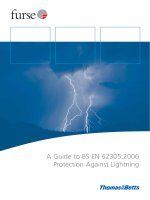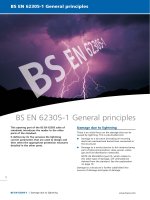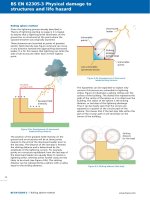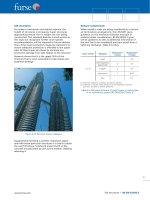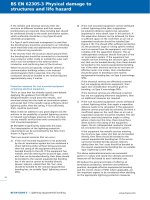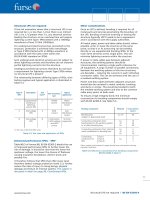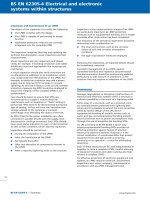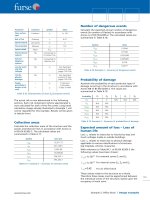Bsi bs en 00845 1 2013 + a1 2016
Bạn đang xem bản rút gọn của tài liệu. Xem và tải ngay bản đầy đủ của tài liệu tại đây (1.89 MB, 68 trang )
BS EN 845-1 :201 3+A1 :201 6
In corpora tin g corrigen dum September 201 3
BSI Standards Publication
Specification for ancillary
components for masonry
Part 1 : Wall ties, tension straps, hangers
and brackets
BRITISH STANDARD
B S E N 845 - 1 : 2 0 1 3 + A1 : 2 0 1 6
National foreword
This British Standard is the UK implementation of
E N 845-1 : 2 01 3 +A1 : 2 01 6. I t su persed es B S E N 845-1 : 2 01 3 wh i ch
i s wi th d ra wn .
Th e sta rt a n d fi n i sh o f te xt i n tro d u ce d o r a l te re d b y a m e n d m e n t
i s i n d i ca te d i n th e te xt b y ta g s. Ta g s i n d i ca ti n g ch a n g e s to CE N
!"
te xt ca rry th e n u m b e r o f th e CE N a m e n d m e n t. F o r e xa m p l e , te xt
a l te re d b y CE N a m e n d m e n t A1
E N 845 -1
i s i n d i ca te d b y
.
sp e ci fi e s th e ch a ra cte ri sti cs a n d p e rfo rm a n ce re q u i re m e n ts
fo r ti e s, j o i st h a n g e rs, stra p s a n d b ra cke ts a va i l a b l e th ro u g h o u t th e
CE N m e m b e r co u n tri e s. I t a i m s to d o so i n p ro d u ct p e rfo rm a n ce
te rm s, a vo i d i n g a s fa r a s p o ssi b l e p re scri p ti ve re q u i re m e n ts a n d a l l
th e tra d i ti o n a l d e si g n a ti o n s o f th e se p ro d u cts a va i l a b l e th ro u g h o u t
E u ro p e .
E N 845 -1
i n cl u d e s cl a u se s co ve ri n g i n i ti a l typ e te sts, fa cto ry
p ro d u cti o n co n tro l , sa m p l i n g fo r i n i ti a l typ e te sti n g a n d
i n d e p e n d e n t te sti n g o f co n si g n m e n ts. Th e se a re si m i l a r i n a l l
m a so n ry p ro d u ct sp e ci fi ca ti o n s.
Th e U K N a ti o n a l An n e x N A a tta ch e d to th i s sta n d a rd p ro vi d e s
a n i n fo rm a ti ve co m m e n ta ry o n th e u se o f B S E N 845 -1
i n th e
U K. N o th i n g i n th i s a n n e x sh o u l d b e co n stru e d a s sp e ci fyi n g
re q u i re m e n ts o th e r th a n th o se co n ta i n e d i n th e n o rm a ti ve p a rts o f
th i s E u ro p e a n S ta n d a rd .
I f CE m a rki n g i s p e rfo rm e d , th e p ro ce d u re s i n An n e x Z A wi l l a p p l y.
Th e si g n i fi ca n ce o f th e CE m a rki n g i s th a t th e p ro d u ct m a n u fa ctu re r
cl a i m s co m p l i a n ce wi th th e “ h a rm o n i z e d ” re q u i re m e n ts g i ve n i n th e
n o rm a ti ve te xt o f th e p ro d u ct sta n d a rd . Th e se re l a te to th e b a si c
re q u i re m e n ts fo r co n stru cti o n wo rks a s g i ve n i n th e Co n stru cti o n
Pro d u cts Re g u l a ti o n . N o t a l l p ro d u ct ch a ra cte ri sti cs n e e d n e ce ssa ri l y
b e g i ve n o n th e CE m a rki n g , b u t th o se p ro d u ct ch a ra cte ri sti cs
co ve re d b y re g u l a ti o n s i n fo rce i n e a ch E U M e m b e r S ta te , wh e re th e
m a n u fa ctu rer i n ten d s th a t th e prod u ct wi l l be u sed , d o n eed to be sta ted .
The UK participation in its preparation was entrusted by Technical
Committee B/51 9, Masonry and associated testing, to Subcommittee
B/51 9/3, Ancillary components.
A l i st o f o rg a n i z a ti o n s re p re se n te d o n th i s su b co m m i tte e ca n b e
o b ta i n e d o n re q u e st to i ts se cre ta ry.
Th i s p u b l i ca ti o n d o e s n o t p u rp o rt to i n cl u d e a l l th e n e ce ssa ry
p ro vi si o n s o f a co n tra ct. U se rs a re re sp o n si b l e fo r i ts co rre ct
a p p l i ca ti o n .
© Th e B ri ti sh S ta n d a rd s I n sti tu ti o n 2 0 1 6 .
Pu b l i sh e d b y B S I S ta n d a rd s Li m i te d 2 0 1 6
I S B N 9 7 8 0 5 80 845 1 8 5
I CS 9 1 . 0 6 0 . 1 0 ; 9 1 . 0 8 0 . 3 0
Compliance with a British Standard cannot confer immunity from
legal obligations.
This British Standard was published under the authority of the
Standards Policy and Strategy Committee on 31 August 201 3.
Amendments/corrigenda issued since publication
Date
Te xt a ffe cte d
30 September 201 3
Correction to supersession details
30 September 201 6
I m p l e m e n ta ti o n o f CE N a m e n d m e n t A1 : 2 01 6 .
N a ti o n a l fo re wo rd a n d N a ti o n a l An n e x N A u p d a te d
EUROPEAN STANDARD
EN 845-1:2013+A1
NORME EUROPÉENNE
EUROPÄISCHE NORM
July 2016
ICS 91.080.30
Supersedes EN 845-1:2013
English Version
Specification for ancillary components for masonry - Part
1: Wall ties, tension straps, hangers and brackets
Spộcification pour composants accessoires de
maỗonnerie - Partie 1: Attaches, brides de fixation,
étriers de support et consoles
Festlegungen für Ergänzungsbauteile für Mauerwerk Teil 1: Maueranker, Zugbänder, Auflager und Konsolen
This European Standard was approved by CEN on 21 March 2013 and includes Amendment 1 approved by CEN on 23 April 2016.
CEN members are bound to comply with the CEN/CENELEC Internal Regulations which stipulate the conditions for giving this
European Standard the status of a national standard without any alteration. Up-to-date lists and bibliographical references
concerning such national standards may be obtained on application to the CEN-CENELEC Management Centre or to any CEN
member.
This European Standard exists in three official versions (English, French, German). A version in any other language made by
translation under the responsibility of a CEN member into its own language and notified to the CEN-CENELEC Management
Centre has the same status as the official versions.
CEN members are the national standards bodies of Austria, Belgium, Bulgaria, Croatia, Cyprus, Czech Republic, Denmark, Estonia,
Finland, Former Yugoslav Republic of Macedonia, France, Germany, Greece, Hungary, Iceland, Ireland, Italy, Latvia, Lithuania,
Luxembourg, Malta, Netherlands, Norway, Poland, Portugal, Romania, Slovakia, Slovenia, Spain, Sweden, Switzerland, Turkey and
United Kingdom.
EUROPEAN COMMITTEE FOR STANDARDIZATION
C O M I TÉ E URO PÉ E N D E N O RM ALI S ATI O N
E URO PÄI S C H E S KO M I T E E FÜR N O RM UN G
CEN-CENELEC Management Centre: Avenue Marnix 17, B-1000 Brussels
© 2016 CEN
All rights of exploitation in any form and by any means reserved
worldwide for CEN national Members.
Ref. No. EN 845-1:2013+A1:2016 E
BS EN 845-1:2013+A1:2016
EN 845-1:2013+A1:2016 (E)
Contents
Page
European foreword ....................................................................................................................................................... 4
1
Scope .................................................................................................................................................................... 5
2
Normative references .................................................................................................................................... 5
3
3.1
3.2
Terms, definitions and symbols ................................................................................................................. 7
Terms and definitions ................................................................................................................................... 7
Symbols ............................................................................................................................................................ 10
4
4.1
4.2
Materials .......................................................................................................................................................... 26
General ............................................................................................................................................................. 26
Fixings and materials not supplied by the manufacturer ............................................................. 26
5
5.1
5.2
5.2.1
5.2.2
Requirements ................................................................................................................................................ 27
General ............................................................................................................................................................. 27
Dimensions and limit deviations ............................................................................................................ 27
Method of measurement and accuracy ................................................................................................ 27
Length, applicable cavity width, embedment and fixings (number, size and
location) ........................................................................................................................................................... 27
5.2.3 Thickness or diameter ............................................................................................................................... 28
5.2.4 Other information ........................................................................................................................................ 28
5.3
Mechanical strength .................................................................................................................................... 29
5.3.1 Wall ties and associated fixings .............................................................................................................. 29
5.3.2 Joist hangers ................................................................................................................................................... 31
5.3.3 Brackets ........................................................................................................................................................... 32
5.3.4 Tension straps ............................................................................................................................................... 33
5.4
Resistance to water crossing a cavity ................................................................................................... 33
5.5
Safety during installation .......................................................................................................................... 34
5.6
Durability ........................................................................................................................................................ 34
5.7
Dangerous substances ................................................................................................................................ 34
6
Description and designation .................................................................................................................... 34
7
Marking ............................................................................................................................................................ 36
8
8.1
8.2
8.2.1
8.2.2
8.2.3
8.2.4
8.3
8.3.1
8.3.2
8.3.3
8.3.4
Assessment and verification of constancy of performance – AVCP............................................ 36
General ............................................................................................................................................................. 36
Type testing .................................................................................................................................................... 36
General ............................................................................................................................................................. 36
Test samples, testing and compliance criteria .................................................................................. 37
Test reports .................................................................................................................................................... 38
Shared other party results ........................................................................................................................ 38
Factory production control (FPC) .......................................................................................................... 38
General ............................................................................................................................................................. 38
Requirements ................................................................................................................................................ 39
Product specific requirements ................................................................................................................ 41
Procedure for modifications .................................................................................................................... 42
Annex A (normative) Materials and protective coatings .............................................................................. 43
Annex B (informative) Guidance on FPC frequencies .................................................................................... 48
2
BS EN 845-1:2013+A1:2016
EN 845-1:2013+A1:2016 (E)
! Annexprovisions
ZA"
Clauses of this European Standard addressing the
of the EU Construction Products Regulation ................................................................ 50
(informative)
ZA.1
Scope and relevant characteristics ........................................................................................................ 50
ZA.2
System of Assessment and Verification of Constancy of Performance (AVCP) ...................... 57
ZA.3
Assignment of AVCP tasks ......................................................................................................................... 57
Bibliography ................................................................................................................................................................. 60
3
BS EN 845-1:2013+A1:2016
EN 845-1:2013+A1:2016 (E)
European foreword
This document (EN 845-1:2013+A1:2016) has been prepared by Technical Committee
CEN/TC 125 “Masonry”, the secretariat of which is held by BSI.
This European Standard shall be given the status of a national standard, either by publication of
an identical text or by endorsement, at the latest by January 2017, and conflicting national
standards shall be withdrawn at the latest by April 2018.
Attention is drawn to the possibility that some of the elements of this document may be the
subject of patent rights. CEN [and/or CENELEC] shall not be held responsible for identifying any
or all such patent rights.
This document includes Amendment 1 approved by CEN on 2016-04-23.
This document supersedes
! EN 845-1:2013" .
!"
The start and finish of text introduced or altered by amendment is indicated in the text by tags
.
This document has been prepared under a mandate given to CEN by the European Commission
and the European Free Trade Association, and supports essential requirements of
EU Directive(s).
For relationship with EU Directive(s), see informative Annex ZA, which is an integral part of this
document.
! deleted text"
EN 845, Specification for ancillary components for masonry, consists of the following parts:
— Part 1 : Wall ties, tension straps, hangers and brackets
— Part 2: Lintels
— Part 3: Bed joint reinforcement of steel meshwork
According to the CEN/CENELEC Internal Regulations, the national standards organizations of
the following countries are bound to implement this European Standard: Austria, Belgium,
Bulgaria, Croatia, Cyprus, Czech Republic, Denmark, Estonia, Finland, Former Yugoslav Republic
of Macedonia, France, Germany, Greece, Hungary, Iceland, Ireland, Italy, Latvia, Lithuania,
Luxembourg, Malta, Netherlands, Norway, Poland, Portugal, Romania, Slovakia, Slovenia, Spain,
Sweden, Switzerland, Turkey and the United Kingdom.
4
BS EN 845-1:2013+A1:2016
EN 845-1:2013+A1:2016 (E)
1 Scope
This European Standard specifies requirements for wall ties, tension straps, hangers and
brackets for interconnecting masonry and for connecting masonry to other parts of works and
buildings including walls, floors, beams, and columns. Where anchors or fasteners are supplied
or specified as part of an ancillary component, the requirements including performance
requirements apply to the complete product.
This European Standard is not applicable to:
a)
anchors and fasteners other than as part of an ancillary component;
b)
shelf angles;
c)
wall starter plates for tying into existing walls;
d)
products formed from materials other than:
1)
austenitic stainless steel (molybdenum chrome nickel alloys or chrome nickel alloys);
2)
austenitic ferritic stainless steel;
3)
ferritic stainless steel;
4)
copper;
5)
phosphor bronze;
6)
aluminium bronze;
7)
zinc-coated-steel with or without organic coating;
8)
polypropylene;
9)
polyamide (for expansion plugs only).
NOTE
The resistance to fire performance of the products included herein cannot be assessed
separately from the masonry element of which they are part and is therefore not covered under the scope
of this part of this European Standard.
2 Normative references
The following documents, in whole or in part, are normatively referenced in this document and
are indispensable for its application. For dated references, only the edition cited applies. For
undated references, the latest edition of the referenced document (including any amendments)
applies.
EN 771 (all parts), Specification for masonry units
EN 846-2, Methods of test for ancillary components for masonry — Part 2: Determination of bond
strength of prefabricated bed joint reinforcement in mortar joints
EN 846-3, Methods of test for ancillary components for masonry — Part 3: Determination of shear
load capacity of welds in prefabricated bed joint reinforcement
5
BS EN 845-1:2013+A1:2016
EN 845-1:2013+A1:2016 (E)
EN 846-4, Methods of test for ancillary components for masonry — Part 4: Determination of load
capacity and load-deflection characteristics of straps
EN 846-5, Methods of test for ancillary components for masonry — Part 5: Determination of
tensile and compressive load capacity and load displacement characteristics of wall ties (couplet
test)
EN 846-6, Methods of test for ancillary components for masonry — Part 6: Determination of
tensile and compressive load capacity and load displacement characteristics of wall ties (single
end test)
EN 846-7, Methods of test for ancillary components for masonry — Part 7: Determination of shear
load capacity and load displacement characteristics of shear ties and slip ties (couplet test for
mortar joint connections)
EN 846-8, Methods of test for ancillary components for masonry — Part 8: Determination of load
capacity and load-deflection characteristics of joist hangers
EN 846-9, Methods of test for ancillary components for masonry — Part 9: Determination of
flexural resistance and shear resistance of lintels
EN 846-10, Methods of test for ancillary components for masonry — Part 10: Determination of
load capacity and load deflection characteristics of brackets
EN 846-11, Methods of test for ancillary components for masonry — Part 11 : Determination of
dimensions and bow of lintels
EN 846-13:2001, Methods of test for ancillary components for masonry — Part 1 3: Determination
of resistance to impact, abrasion and corrosion of organic coatings
EN 846-14, Methods of test for ancillary components for masonry — Part 1 4: Determination of the
initial shear strength between the prefabricated part of a composite lintel and the masonry above
it
EN 998-2, Specification for mortar for masonry — Part 2: Masonry mortar
EN 10020, Definitions and classification of grades of steel
EN 10029, Hot-rolled steel plates 3 mm thick or above — Tolerances on dimensions and shape
EN 10088 (all parts), Stainless steels
EN 10143, Continuously hot-dip coated steel sheet and strip — Tolerances on dimensions and
shape
EN 10244 (all parts), Steel wire and wire products — Non-ferrous metallic coatings on steel wire
EN 10245-1, Steel wire and wire products — Organic coatings on steel wire — Part 1 : General
rules
EN 10245-2, Steel wire and wire products — Organic coatings on steel wire — Part 2: PVC
finished wire
6
BS EN 845-1:2013+A1:2016
EN 845-1:2013+A1:2016 (E)
EN 10245-3, Steel wire and wire products — Organic coatings on steel wire — Part 3: PE coated
wire
EN 10346, Continuously hot-dip coated steel flat products — Technical delivery conditions
EN ISO 75 (all parts), Plastics — Determination of temperature of deflection under load
EN ISO 178, Plastics — Determination of flexural properties (ISO 1 78)
EN ISO 180:2000, Plastics — Determination of Izod impact strength (ISO 1 80:2000)
EN ISO 306, Plastics — Thermoplastic materials — Determination of Vicat softening temperature
(VST) (ISO 306)
EN ISO 527 (all parts), Plastics — Determination of tensile properties
EN ISO 1133 (all parts), Plastics — Determination of the melt mass-flow rate (MFR) and melt
volume-flow rate (MVR) of thermoplastics
EN ISO 1461, Hot dip galvanized coatings on fabricated iron and steel articles — Specifications
and test methods (ISO 1461 )
EN ISO 1463, Metallic and oxide coatings — Measurement of coating thickness — Microscopical
method (ISO 1 463)
EN ISO 2039-2, Plastics — Determination of hardness — Part 2: Rockwell hardness (ISO 2039-2)
ISO 427, Wrought copper-tin alloys — Chemical composition and forms of wrought products
ISO 428, Wrought copper-aluminium alloys — Chemical composition and forms of wrought
products
ISO 431, Copper refinery shapes
ISO 1183 (all parts), Plastics — Methods for determining the density of non-cellular plastics
3 Terms, definitions and symbols
3.1 Terms and definitions
For the purposes of this document, the following terms and definitions apply.
NOTE
Dimensions and terms relating to wall ties are given in Figure 1.
3.1.1
asymmetrical tie
1) wall tie which is of a different physical design at either end over its embedment depth (or
end fixing) and for which the centre section may be symmetrical or asymmetrical in detail
Note 1 to entry:
Examples are given in Figure 2 a).
2) wall tie which is physically identical at either end over its embedment depth (or end fixing)
but which is fixed in a different manner at each end is also defined as asymmetrical for the
purposes of the test procedure
7
BS EN 845-1:2013+A1:2016
EN 845-1:2013+A1:2016 (E)
Note 2 to entry:
Examples are given in Figure 2 b) .
3.1.2
bracket
device attached to structural elements, comprising an individual support for two adjacent
masonry units, which form part of a masonry wall
Note 1 to entry:
Examples are given in Figure 3.
3.1.3
cavity wall tie
device for connecting a masonry leaf across a cavity to another masonry leaf or to a structural
frame to resist tension and compression forces while allowing limited differential movement in
the plane of the wall
Note 1 to entry:
Examples are given in Figure 2 and Figure 4.
Note 2 to entry:
Wall ties are further sub classified as asymmetrical or symmetrical and as horizontal,
slope-tolerant or movement-tolerant. Examples are given in Figures 2 , 4 and 5 respectively.
3.1.4
cavity width
distance between the cavity faces of the masonry leaves of a cavity wall, measured
perpendicular to the plane of the wall
3.1.5
declared value
value for a product property, determined in accordance with this standard, that a manufacturer
is confident of achieving bearing in mind the variability of the manufacturing process
3.1.6
minimum embedment length
minimum length to achieve the declared value of a wall tie, or hanger designed to be embedded
in mortar
Note 1 to entry:
The specification for the length to be built into the wall should be greater than the
minimum used by the manufacturer for the declaration, so as to allow for tolerances in positioning on site
(see Figure 1).
3.1.7
fixing
device (e.g. a nail, screw, screw/plug, anchor or bolt) used to connect ancillary components to
masonry or to supporting structures to resist tension and shear forces
3.1.8
horizontal wall tie
cavity wall tie which is designed to be installed approximately horizontally and in the plane of
the mortar joint across a cavity
Note 1 to entry:
Examples are given in Figure 2 and Figure 4.
3.1.9
joist hanger (face fixing type)
device for supporting a joist, beam, truss or rafter on a masonry wall via fixing bolts or screws
8
BS EN 845-1:2013+A1:2016
EN 845-1:2013+A1:2016 (E)
Note 1 to entry:
Examples are given in Figure 6.
3.1.10
joist hanger (joint fixing type)
device for supporting a joist, beam, truss or rafter on a masonry wall by direct loading via a
flange which is embedded in a mortar joint
Note 1 to entry:
Examples are given in Figure 7.
3.1.11
load capacity 1)
individual value of the failure load, or load at an extreme displacement, given in the appropriate
test method, whichever is the lesser
3.1.12
tensile/compressive/shear load capacity
mean of the load capacities of the number of wall ties tested in tension/compression/shear
3.1.13
vertical load capacity
mean of the load capacities of the number of joist hangers/brackets tested
3.1.14
movement-tolerant cavity wall tie
cavity wall tie which is designed to allow large in-plane differential movements of the walls,
without generating large shear stresses, by the use of flexible body materials, free-running slot
systems, articulated joints or other means
Note 1 to entry:
Examples are given in Figure 8 and Figure 9.
3.1.15
profile height
maximum overall height (distance between the upper and lower surface at right angles to the
length and width of the joint) of the embedded portion of a wall tie, strap or hanger
Note 1 to entry:
See Figure 1.
3.1.16
shear tie
wall tie designed to transmit shear, tension and compression forces between two adjacent
sections of masonry or between structural frames and masonry
Note 1 to entry:
Figure 10.)
Shear ties are sub-classified as symmetrical or asymmetrical. (Examples are given in
1) A convention has been adopted in this standard for terminology relating to the term ‘load capacity’. It is also used
in the EN 846 (all parts) test methods, which support EN 845. This term without a preceding qualifying adjective as
shown in 3.1.11 denotes an individual value of ‘load capacity’, i.e. the result of one measurement on one specimen.
Where the term is used with a preceding qualifying adjective, e.g. ‘tensile load capacity’ (see 3.1.12), this relates to the
mean of the load capacities from a number of specimens tested.
9
BS EN 845-1:2013+A1:2016
EN 845-1:2013+A1:2016 (E)
3.1.17
slip tie (general purpose)
wall tie designed to transmit only shear forces between two adjacent sections of masonry or
between masonry and structural frames while allowing in-plane movement
Note 1 to entry:
Examples are given in Figure 11.
3.1.18
slope-tolerant tie
cavity wall tie designed to function satisfactorily with a significant slope from the horizontal
Note 1 to entry:
Examples are given in Figure 5.
3.1.19
slot tie
wall tie whose end fixing (at one end) is by means of engaging a re-entrant key (e.g. dovetail)
into a slot either embedded in a concrete wall or surface fixed to concrete, steel or masonry
walls or frame elements, and which is free to slide in the slot either only during installation (for
adjustment purposes) or both during installation and while in service (to allow differential
movement)
Note 1 to entry:
Examples are given in Figure 9.
3.1.20
symmetrical tie
wall tie which is physically identical at each end over its embedment length (or end fixing) and
which is fixed in an identical manner at each end
Note 1 to entry:
The centre section may be symmetrical or asymmetrical in detail.
Note 2 to entry:
Examples are given in Figure 4.
3.1.21
tension strap
device for connecting masonry walls to other adjacent components such as floors and roofs and
which resists tension forces
Note 1 to entry:
Examples are given in Figure 12.
3.1.22
wall tie
device capable of transferring loads between masonry leaves or between masonry and other
structures, in order to limit their relative movement in purely one or more planes, as required
Note 1 to entry:
Examples are given in Figure 1, Figure 2, Figure 4, Figure 8 and Figure 10.
3.2 Symbols
L
NOTE
10
the overall perpendicular length of a bracket from the fixing surface to the extremity of the
support flange, in mm
Examples are given in Figure 3.
BS EN 845-1:2013+A1:2016
EN 845-1:2013+A1:2016 (E)
Key
1 profile height
5 cavity width
9 insulation
2 mortar joint thickness
6 drip
10 inner leaf material, e.g. timber
3 units forming outer 7 insulation
leaf
clip
4 embedment length
retaining 11 diameter of wire or thickness of
plate
8 insulation width
Figure 1 — Dimensions and terms relating to wall ties
11
BS EN 845-1:2013+A1:2016
EN 845-1:2013+A1:2016 (E)
NOTE 1
For reasons of clarity, thermal insulation is not shown.
Key
1 thin layer mortar (far end)
4 screwed to timber frame
2 screw fixing
5 nailed to timber frame
3 resin anchor fixing
6 bedded in mortar (near end)
a) Examples of asymmetrical wall ties
12
BS EN 845-1:2013+A1:2016
EN 845-1:2013+A1:2016 (E)
NOTE 2
For reasons of clarity, thermal insulation is not shown.
Key
1
deformed plate tie in masonry mortar (near end) and thin joint mortar (far end)
2
helical tie in masonry mortar (near end) and screwed into block (far end)
b) Examples of symmetrical wall ties used asymmetrically
Figure 2— Examples of wall ties
13
BS EN 845-1:2013+A1:2016
EN 845-1:2013+A1:2016 (E)
Key
a)
ribbed-plate
shim)
adjuster
type
(and packing
b)
screwed adjuster type (and packing shim)
c)
toothed support and angled slot adjuster type
d)
light duty cam washer adjuster type
Figure 3 — Examples of brackets
14
BS EN 845-1:2013+A1:2016
EN 845-1:2013+A1:2016 (E)
NOTE
For reasons of clarity, thermal insulation is not shown.
Key
1 thin plate types
3 thick plate types
2 helical (spiral) types
4 wire types
Figure 4 — Examples of symmetrical wall ties
15
BS EN 845-1:2013+A1:2016
EN 845-1:2013+A1:2016 (E)
NOTE
For reasons of clarity, thermal insulation is not shown.
Key
1
installed with favourable slope
2
installed level
3
installed with unfavourable slope
Figure 5 — Examples of slope-tolerant cavity wall ties
16
BS EN 845-1:2013+A1:2016
EN 845-1:2013+A1:2016 (E)
Key
L
clear length of joist hanger flange
Figure 6 — Example of joist hangers (face-fixing type)
17
BS EN 845-1:2013+A1:2016
EN 845-1:2013+A1:2016 (E)
Figure 7 — Example of joist hanger (joint fixing type)
18
BS EN 845-1:2013+A1:2016
EN 845-1:2013+A1:2016 (E)
NOTE
For reasons of clarity, thermal insulation is not shown.
Key
1
universal-jointed type
2
sliding tee-in-slot type
a) Examples of movement-tolerant cavity wall ties
19
BS EN 845-1:2013+A1:2016
EN 845-1:2013+A1:2016 (E)
Key
1
rod with eye which can slide up or down
b) Example of movement-tolerant cavity wall tie having rod and eye that can be fixed to inner
leaf of the wall
Figure 8 — Examples of movement-tolerant cavity wall ties
20
BS EN 845-1:2013+A1:2016
EN 845-1:2013+A1:2016 (E)
NOTE
For reasons of clarity, thermal insulation is not shown.
Key
1
face-mounted key slot
2
sliding tee-in-slot type
3
key slot
4
dovetail slot
Figure 9 — Examples of slot ties
21
BS EN 845-1:2013+A1:2016
EN 845-1:2013+A1:2016 (E)
NOTE
For reasons of clarity, thermal insulation is not shown.
Key
1
symmetrical split-ended anchor type
2
asymmetrical tee type
Figure 10 — Examples of shear ties
22
BS EN 845-1:2013+A1:2016
EN 845-1:2013+A1:2016 (E)
Key
1
asymmetrical fixing/slip-case type
2
symmetrical slip-case type
3
asymmetrical split-ended/slip-case type
Figure 11 — Examples of slip ties (general purpose type)
23

